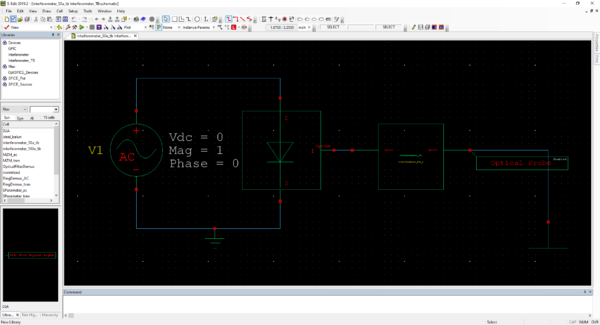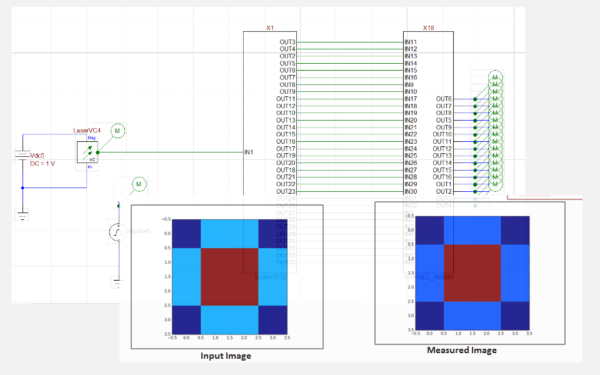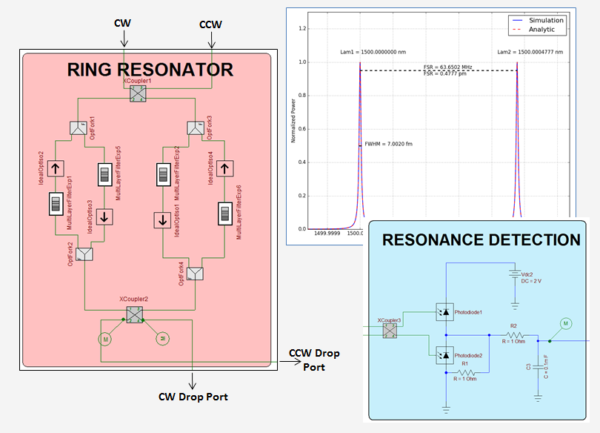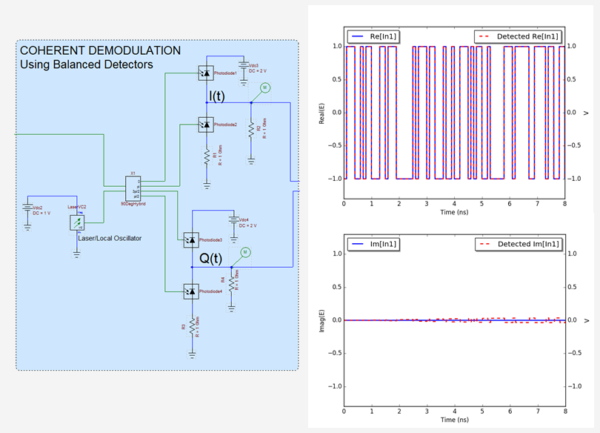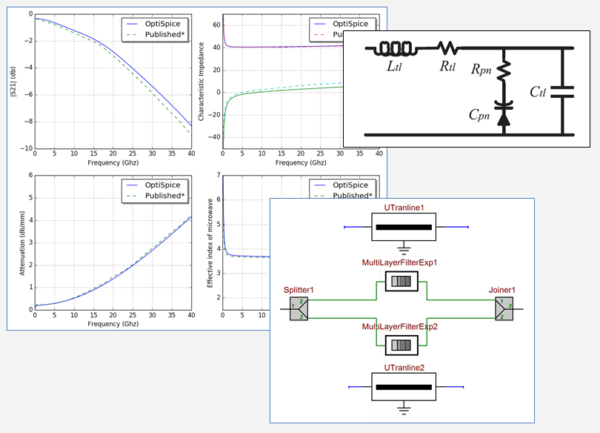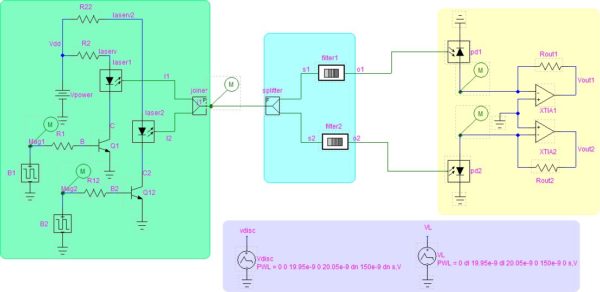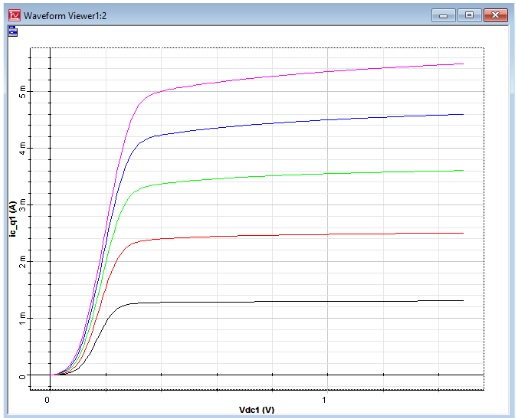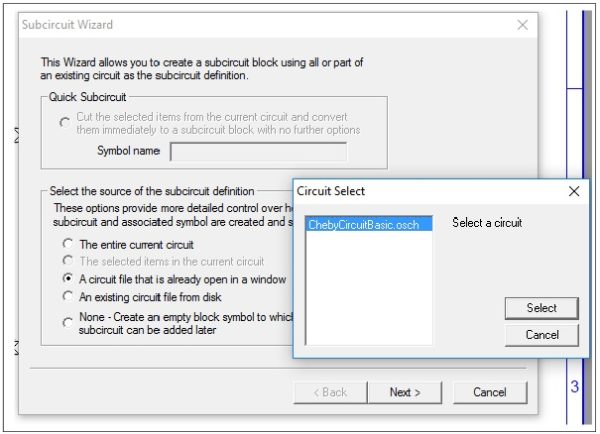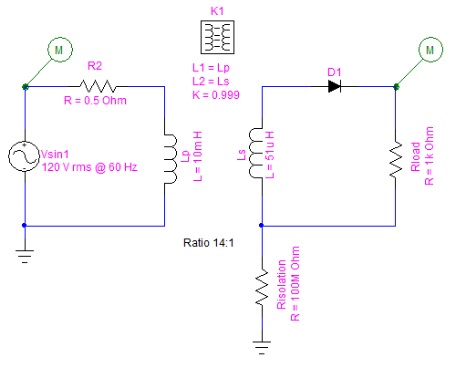OptiSPICE, a premier product from Optiwave, enables the design and simulation of optoelectronic circuits at the transistor level, encompassing a broad spectrum of components from laser drivers to transimpedance amplifiers, optical interconnects, and electronic equalizers. As the first circuit design software to analyze integrated circuits incorporating both optical and electronic components, OptiSPICE stands at the forefront of technological innovation. Our tool is critical in driving advancements in various sectors, including fiber optic communication, sensing, and more. Optiwave’s dedication to pioneering integrated optoelectronic solutions is evident in OptiSPICE, reflecting our expertise and leadership in the field of optoelectronic systems.
- Applications
Applications
Optiwave software can be used in different industries and applications, including Fiber Optic Communication, Sensing, Pharma/Bio, Military & Satcom, Test & Measurement, Fundamental Research, Solar Panels, Components / Devices, etc..
Stay up-to-date with the latest updates
- Products
Products
- OptiSystem
- OptiInstrument
- OptiSPICE
- OptiFDTD
- OptiBPM
- OptiFiber
- OptiGrating
- OptiConverge
OptiSystemOptiSystem is a comprehensive software design suite that enables users to plan, test, and simulate optical links in the transmission layer of modern optical networks.
OptiInstrumentOptiInstrument addresses the needs of researchers, scientists, photonic engineers, professors and students who are working with instruments.
OptiSPICEOptiSPICE is the first circuit design software for analysis of integrated circuits including interactions of optical and electronic components. It allows for the design and simulation of opto-electronic circuits at the transistor level, from laser drivers to transimpedance amplifiers, optical interconnects and electronic equalizers.
OptiFDTDOptiFDTD is a powerful, highly integrated, and user friendly CAD environment that enables the design and simulation of advanced passive and non-linear photonic components.
OptiBPMOptiBPM is a comprehensive CAD environment used for the design of complex optical waveguides. Perform guiding, coupling, switching, splitting, multiplexing, and demultiplexing of optical signals in photonic devices.
OptiFiberOptiFiber The optimal design of a given optical communication system depends directly on the choice of fiber parameters. OptiFiber uses numerical mode solvers and other models specialized to fibers for calculating dispersion, losses, birefringence, and PMD.OptiGratingEmerging as a de facto standard over the last decade, OptiGrating has delivered powerful and user friendly design software for modeling integrated and fiber optic devices that incorporate optical gratings.
OptiConvergeOptiConverge is a collaborative integration framework that seamlessly combines two or more Optiwave products (e.g., OptiSystem, OptiSPICE, OptiFDTD, etc.) and other third party products into unified solutions. Designed to streamline complex workflows, it empowers users to achieve their goals faster by harnessing the collective power of our trusted Optiwave tools.- OptiSystem-Luceda
- OptiSPICE-Tanner
- OptiSystem-GDSFactory
- OptiSystem-FDTD/BPM
- OptiSystem-Tanner
- OptiSystem-OptiSPICE
- OptiSPICE-FDTD/BPM
- OptiSystem with other tools
Learn more about our products
- Downloads
Downloads
Download our 30-day Free Evaluations, lab assignments, and other freeware here.
Learn more about our 30-Day Evaluations
- Support
Support
Ask a questions

Want to learn more?
- Forum Login
- Applications
Applications
Optiwave software can be used in different industries and applications, including Fiber Optic Communication, Sensing, Pharma/Bio, Military & Satcom, Test & Measurement, Fundamental Research, Solar Panels, Components / Devices, etc..
Stay up-to-date with the latest updates
- Products
Products
- OptiSystem
- OptiInstrument
- OptiSPICE
- OptiFDTD
- OptiBPM
- OptiFiber
- OptiGrating
- OptiConverge
OptiSystemOptiSystem is a comprehensive software design suite that enables users to plan, test, and simulate optical links in the transmission layer of modern optical networks.
OptiInstrumentOptiInstrument addresses the needs of researchers, scientists, photonic engineers, professors and students who are working with instruments.
OptiSPICEOptiSPICE is the first circuit design software for analysis of integrated circuits including interactions of optical and electronic components. It allows for the design and simulation of opto-electronic circuits at the transistor level, from laser drivers to transimpedance amplifiers, optical interconnects and electronic equalizers.
OptiFDTDOptiFDTD is a powerful, highly integrated, and user friendly CAD environment that enables the design and simulation of advanced passive and non-linear photonic components.
OptiBPMOptiBPM is a comprehensive CAD environment used for the design of complex optical waveguides. Perform guiding, coupling, switching, splitting, multiplexing, and demultiplexing of optical signals in photonic devices.
OptiFiberOptiFiber The optimal design of a given optical communication system depends directly on the choice of fiber parameters. OptiFiber uses numerical mode solvers and other models specialized to fibers for calculating dispersion, losses, birefringence, and PMD.OptiGratingEmerging as a de facto standard over the last decade, OptiGrating has delivered powerful and user friendly design software for modeling integrated and fiber optic devices that incorporate optical gratings.
OptiConvergeOptiConverge is a collaborative integration framework that seamlessly combines two or more Optiwave products (e.g., OptiSystem, OptiSPICE, OptiFDTD, etc.) and other third party products into unified solutions. Designed to streamline complex workflows, it empowers users to achieve their goals faster by harnessing the collective power of our trusted Optiwave tools.- OptiSystem-Luceda
- OptiSPICE-Tanner
- OptiSystem-GDSFactory
- OptiSystem-FDTD/BPM
- OptiSystem-Tanner
- OptiSystem-OptiSPICE
- OptiSPICE-FDTD/BPM
- OptiSystem with other tools
Learn more about our products
- Downloads
Downloads
Download our 30-day Free Evaluations, lab assignments, and other freeware here.
Learn more about our 30-Day Evaluations
- Support
Support
Ask a questions

Want to learn more?
- Forum Login
OptiSPICE: Optoelectronic Circuit Simulation Software
Home » Optiwave Products » OptiSPICE: Optoelectronic Circuit Simulation Software
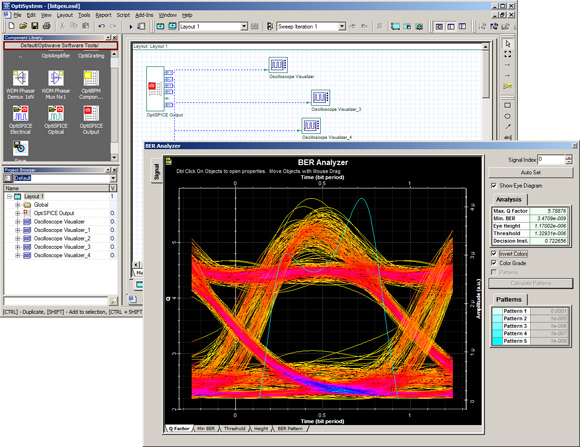
Applications
Bridging the Gap Between Photonics and Electronics
In the ever-evolving landscape of electronics and photonics, OptiSPICE is an indispensable tool, providing a robust simulation framework essential for the coexistence of electrical and optical components at the chip and board level. This advanced optoelectronic circuit simulation software suite is designed to deliver accurate and efficient predictions of signal behavior in optoelectronic integrated circuits and boards, ensuring high-quality design and reliability.
Key features and benefits:
- Self-Consistent Solutions: OptiSPICE excels in generating solutions for circuits that encompass both optical and electrical feedback, offering a comprehensive view of the system’s performance.
- Integrated Design Platform: It serves as a one-stop solution for parameter extraction, schematic capture, optoelectronic circuit simulation, and waveform analysis, streamlining the design process and enhancing productivity.
- Wide Application Spectrum: OptiSPICE’s versatility is evident in its wide range of applications, including:
- Tanner Plugin Integration for streamlined design workflows.
- Advanced simulations for Nano Photonic Imagers, Ring Resonator Fiber Optic Gyroscopes and Lidar systems.
- Critical components like Optical Phase Locked Loops for Analog Homodyne Detection and high-speed modulators like the 40 Gbps Silicon Depletion Mode TW Modulator.
- Innovative applications in Channel Switching Circuits, MEMS-based solutions, Electroabsorption Modulators, Ring Switches, VCSEL Arrays, and Power Control Designs.
- Learning and Support: To ensure users can maximize the potential of OptiSPICE, Optiwave provides an extensive array of tutorials and videos. These resources are designed to help new and experienced users understand the software’s capabilities and apply them effectively in their projects.
Tutorials
Embark on a Revolutionary Design Experience with a Free evaluation
OptiSPICE is not just a software solution; it’s a gateway to the future of optoelectronic circuit design and simulation, offering unmatched precision, versatility, and support. Ready to get started? Experience the unparalleled advantage of direct access to our expert development and support team throughout your evaluation period. At Optiwave, we offer personalized, hands-on support, ensuring your queries are answered promptly and effectively. Our extensive software suite, backed by a rich legacy and innovation since 1994, caters to a wide array of applications.
Explore the possibilities and see the difference for yourself with our no-obligation 30-day evaluation. Embrace the future of optoelectronic systems design with Optiwave today.
Resources
NEW VERSION OptiSPICE 6.0
OptiSPICE Publication References – 2018
OptiSPICE Publication References – 2019
More Optiwave Products
OptiConverge
OptiConverge is not a product but a group of integration products which can combine two or more products together to accomplish our user’s goal.
OptiTest
OptiFDTD is a powerful, highly integrated, and user friendly CAD environment that enables the design and simulation of advanced passive and non-linear photonic components.
OptiSystem: Comprehensive Optical System Design Software
OptiSystem is a comprehensive software design suite that enables users to plan, test, and simulate optical links in the transmission layer of modern optical networks.
OptiFDTD Software
OptiFDTD is a powerful, highly integrated, and user friendly CAD environment that enables the design and simulation of advanced passive and non-linear photonic components.
OptiInstrument: Optical System Testing
OptiInstrument 2.0 is a new released software by Optiwave that addresses the needs of researchers, scientists, photonic engineers, professors and students who are working with instruments.
OptiBPM
OptiBPM is a comprehensive CAD environment used for the design of complex optical waveguides. Perform guiding, coupling, switching, splitting, multiplexing, and demultiplexing of optical signals in photonic devices.
OptiFiber
The optimal design of a given optical communication system depends directly on the choice of fiber parameters. OptiFiber uses numerical mode solvers and other models specialized to fibers for calculating dispersion, losses, birefringence, and PMD.
OptiGrating
Emerging as a de facto standard over the last decade, OptiGrating has delivered powerful and user friendly design software for modeling integrated and fiber optic devices that incorporate optical gratings.

